For most of the last millennium the basic units of local government were townships. These were divisions within the ecclesiastical parishes which gradually gained civic and administrative responsibilities as society became more sophisticated. Bredbury and Romiley were two separate townships in the Middle Ages but they were brought together in the nineteenth century in order to establish units of local government. First as a Local Board, then as a sanitary district and finally, after 1894, as an urban district council, it was a unified authority. In 1976 it lost its autonomy when it was brought under the control of Stockport MBC at the same time as Marple UDC.

Welkin Mill
The authority is adjacent to Marple and many of the same factors influenced the growth of industry in the two townships as in Marple but there were and are distinct differences. Industrial activity began earlier in Ludworth and Mellor because of the fast-flowing streams which provided adequate power for early mills. Nevertheless the two districts had much in common. There were workable coal deposits in both areas, the Peak Forest Canal was cut through Woodley, Romiley and Marple from north to south from 1794 to 1806 and the railway was brought in during the 1860s. At first the industry which came into the area was dominated by cotton but in Bredbury and Romiley, unlike Marple, it diversified and by the mid nineteenth century there was a wide base of industrial activity.
Probably the first organised industry in Bredbury and Romiley was the milling of corn but this activity was greatly circumscribed by the feudal customs of the time. A manorial lord could oblige his tenants to have their corn ground at his mill and most took advantage of this monopoly. There were two main mills involved involved in the district. The mill owned by the Arderne family was situated on the Tame, near Arden Hall. The Davenport family mill in Bredbury was on the Goyt, immediately below Otterpool Bridge.
The next industry to develop in Bredbury and Romiley was coal mining. At first coal was only used for iron smelting and lime burning but by Tudor times it began to replace wood as a source of home heating. The earliest workings in the area were where seams outcropped at the surface or were ex-posed in river banks. These were followed by bell pits - shafts dug down to shallow  Lingard Lane Collieries c.1946. This view is from the former toll house that stood at the junction of Lingard Lane and Ashton Road. An air-raid shelter stands by the side of Lingard Lane with a blast wall to protect the entrance. The small structure to the right of this is probably an RAC telephone box.) [click the image to see Bredbury Colliery]seams which were then worked outwards until the danger of collapse forced the pit to be abandoned. A group of pits shown in a field alongside Stockport Road East in Bredbury in a plan of 1710 would have been of this type.
Lingard Lane Collieries c.1946. This view is from the former toll house that stood at the junction of Lingard Lane and Ashton Road. An air-raid shelter stands by the side of Lingard Lane with a blast wall to protect the entrance. The small structure to the right of this is probably an RAC telephone box.) [click the image to see Bredbury Colliery]seams which were then worked outwards until the danger of collapse forced the pit to be abandoned. A group of pits shown in a field alongside Stockport Road East in Bredbury in a plan of 1710 would have been of this type.
It was a very primitive industry at first but gradually technologies were developed that allowed miners to dig deeper and to follow seams for longer. This expansion was encouraged because of a higher demand for coal. By the 1700s it was required not just for the domestic purposes of a growing popu-lation but also to fuel the local brick-making industry. In 1745 Richard Arderne of Arden Hall bought coal from a local mine owner for the brick kiln which he had recently erected on his Bredbury estate. At Woodley in 1732 a local landowner who had exhausted the seams beneath his own estate leased the right to continue his workings under the neighbouring land of Richard Arderne. By 1762 the Ardennes were themselves involved in mining, operating two pits in Bredbury in which they employed seven full-time colliers. Productivity was obviously improving as by the early 1780s only one of these pits was still being worked with the same total number of men but the maximum weekly output was nearly three times that of 1762.
Rises in production were achieved by digging mines of greater size and depth but this also increased the problems of ventilation and drainage. In the Arderne pits a chain pump was used to drain the primitive mines. By the mid 1770s a weir across the Tame near Woodley provided a weir for a wheel serving the coal workings. When Thomas Newcomen invented the atmospheric engine this allowed mines to go deeper and enabled drowned pits to be pumped dry and opened up again. However, most Bredbury pits were too small to merit this level of investment but their use was known and understood. An atmospheric engine was in use in Norbury before 1764.
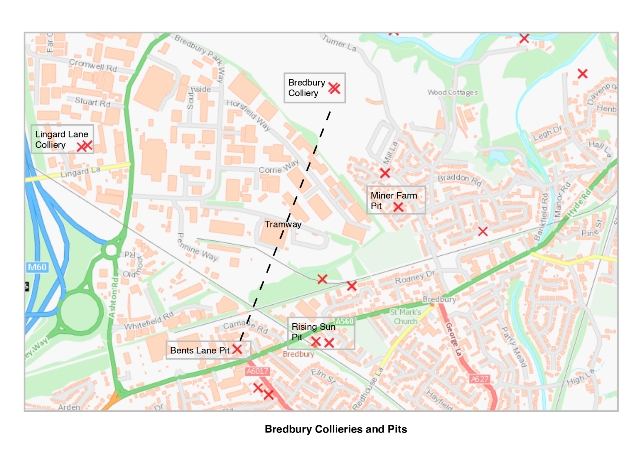
It was the steam engine developed by James Watt that really made a difference to conditions in the mines. His condensing steam engine allowed pits to be dug to depths of 400 or 500 feet. A decade later the double-acting steam engine had been perfected allowing air to be pumped down the shafts and water brought up. The mines became much more mechanised with lifts for men and for coal. Only a few of the mines in Bredbury and Romiley had coal in sufficient quantities to justify this type of capital investment; the remainder either carried on as small-scale operations or closed down completely.
There are old pits all over the district. The official Coal Authority record shows about thirty old and abandoned mine shafts, mainly north of the A560, the Stockport Road leading to Hyde and along the Tame valley. In addition it recognised that there were probably twice as many which were worked then abandoned before records were kept. However there were larger collieries which were worked up to a more recent date and which had higher levels of investment. There were five main concentrations of mining activity:
- Lingard Lane Colliery
- Miner Farm Pit in Woodley
- Rising Sun Pit (adjacent to Bredbury station)
- Bents Lane Pit
- Bredbury Colliery (near Bredbury Park Industrial Estate)
A tramway linked the Bents Lane Pit and the Bredbury Colliery in order to make more efficient use of screening and loading equipment.
However, coal in this area could not compete with the high quality coal from other areas, particularly the Lancashire coalfield and, even more important, the Yorkshire coalfield.
There are now few traces of the coal mining that went back to the 17th century at least and in the 19th century was one of the bases of life in the village. The last colliery closed in 1926 and spoil heaps were levelled at Ashton Road and Stockport Road East in the 1960s to make way for new industrial development. Brick-making too was carried on in the village, with Jacksons Brickworks at Ashton Road surviving into the 1970s.
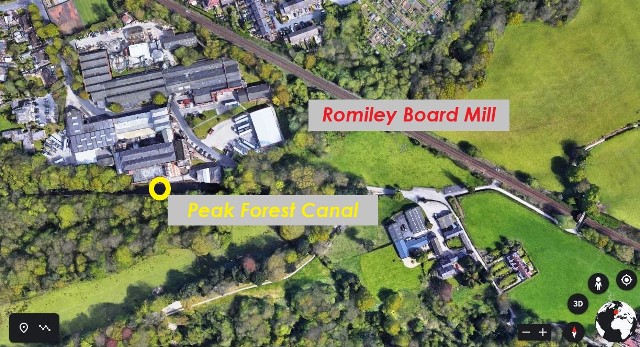 Peak Forest Canal and Romiley Board Mill [from Google Earth]
Peak Forest Canal and Romiley Board Mill [from Google Earth]
click the image to see a close view
The other major influence on the development of industry was the Peak Forest Canal which cut through Bredbury and Romiley from north to south, offering convenient and cheap access both to and from potential sites. Although the canal was completed by 1800 in this area, giving routes to Ashton and Manchester, industry did not follow immediately because there were few sources of water power and steam power was in early stage of development. Even by the time of the tithe map in the 1840s there were few cotton mills on the ground and it was not until the second half of the nineteenth century when other industries were established. The canal was the focus for most developments but the railway was completed by 1865 and that too increased the attraction of this area for industrial developments.
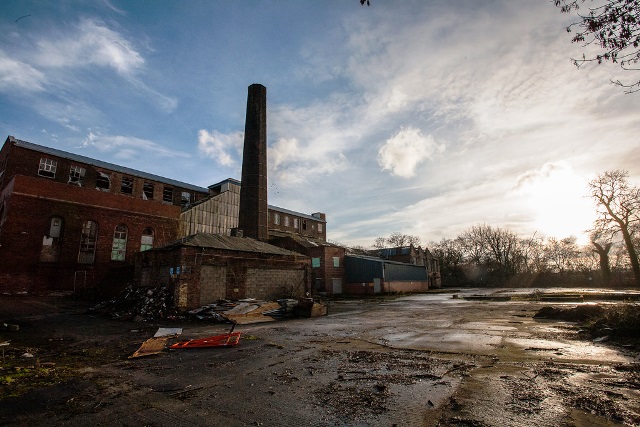
Trianon Mill aka Unity Mill (click the image to see the interior of the mill)
Following the canal from the northern border of Bredbury, Bridge 10, Murray’s Bridge, is a footbridge giving access to Unity Mill. Although the mill stands well back from the canal it had its own wharf for importing and exporting. The wharf probably pre-dates the mill and was originally part of a canal basin that served the Hall Lane Colliery which was extant before 1829. Originally known as Trianon Mill, it was built in the 1860s for cotton spinning. In 1878 Charles Taylor took out a twenty-year lease on the mill in order to manufacture Corticene cork Floor cloth (a harder wearing type of linoleum). By the 1890s it was converted to a rubber works and then back to a textile mill. From the 1950s it manufactured food products and animal feed but production ceased in 2002 and it remained empty for two decades. Currently it is in a very poor state although not derelict.
- Wood Mill
- Bottom Mill aka Botany Mill aka Wellington Mill
- Middle Mill aka Thorn Works
- Top Mill
Woodley Bridge (Bridge 12) provided access to what would have been a busy area in the 1840s. At that time there were three bone mills, grinding bones to make fertiliser which was in great demand. The largest was Wood Mill, on the banks of the Thame, owned by William Vaudrey. The imaginatively named Top and Middle Mills were both owned by John Leigh. Top Mill stood near the canal on Bankfield Road whilst Middle Mill was a short distance below the canal on Mill Lane. All the Mills were originally water-powered, the source of energy being a fast flowing stream which rose near the top of Manor Road and flowed under the canal to the river. It was damned at each mill to give a regular flow.
In 1864 Wood Mill was taken over by John Lees Buckley. The family originally came from Oldham but had lived in Stockport for many years before moving to Woodley. He owned several mills in Woodley and was a major employer as well as being a keen Methodist and philanthropist. The North Cheshire Herald of 24th January 1864 describes his business as “fur blowing, carding for the roughers of that day and also a little wool washing.” These were all materials used by the hatting industry. Eight years later he was described in Worall’s Directory as a wool carder and hatter. At that time 100 men were employed at Wood Mill. Over the ensuing period he embarked on a major rebuilding programme for all his mills.
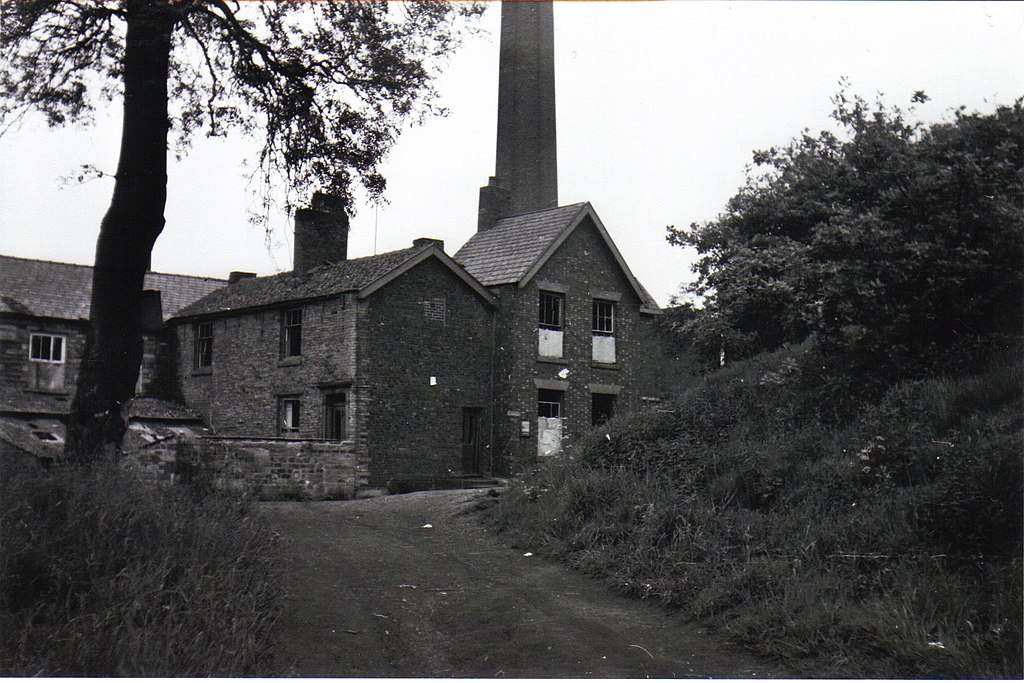
Wood Mill, just prior to demolition (1963)
The 1914-18 war proved to be a significant turning point for all these mills. After the First War, Wood Mill was sold to Ashbrooks Ltd, a firm of colour manufacturers. They, in turn, relinquished it to Fletcher’s Dye Works. It was demolished in 1964. In 1914 Botany Mill became a rubber works and it was then occupied by the Wellington Varnish Company, changing its name to Wellington Works. By 1914 Middle Mill was known as Thorn Works and it was occupied by a firm engaged in the hatting and furrier industry. Much more recently it has been occupied by T.A.Knox, a firm of shopfitters. In 2016 they applied for planning permission to convert the building to residential apartments. Top Mill has altered very little since the extension was added. The Buckleys sold it in 1909 to a firm manufacturing chamois leathers and gloves and in 1934 it was bought by MacPhail and Kay, who also made gloves.
- Woodley Wharf
- Vaudrey’s Wharf
- Ashton Private Branch
- Woodley Mill
- Star Mill
Just beyond Woodley Wharf was another concentration of industrial activity. The area was known collectively as Woodley Wharf but it comprised two separate wharves, a private branch leading to Woodley Mill and another mill, State Mill. There was a variety of small firms based in this area but most were dependent upon Woodley Mill to a greater or lesser extent.
Woodley Mill

Woodley Mill Steam Engine (The engine was removed in the period 1988-89 and after passing through various owners has been sold on for private preservation. Its current whereabouts are not known.)
By the late 1820s steam power had come of age and it was becoming the sole source of power for new mills. They then had more freedom of choice for location and most chose canalised sites because of the convenient transport links. Among the first was Woodley Mill. Built in 1828 by Samuel Ashton, it was one of the earliest fireproofed mills in the country. Internally it has an iron frame with brick arches evidence of shafting suggests that the mill was designed for throstle rather than mule spinning. It is a Grade II listed building. The Ashton family owned mills in Hyde, Godley and Gerrards Wood which in total employed many hundreds of people. They were particularly noted for operating mills that carried out both spinning and weaving at a time when most mills concentrated on one process. Part of the mill was demolished in 1881 but the greater part continued and was sold to J Salmon & Son in the 1890s. This company operated as printers’ engineers but they, in turn, sold the premises in 1915. J.G.Naylor bought the mill to manufacture abrasive materials, particularly flexible abrasives in the form of sheets, rolls, discs and belts and they worked here until the current century.
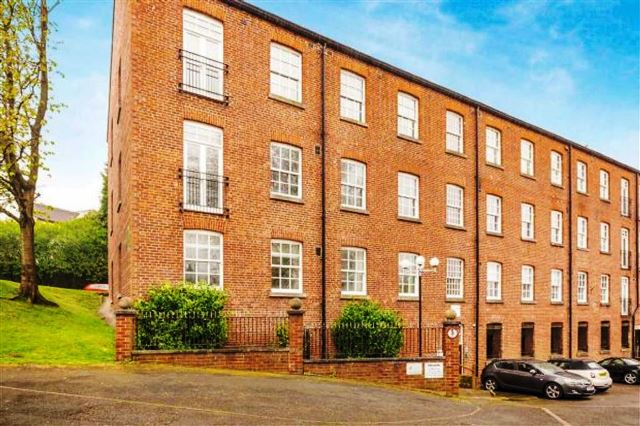 Woodley Mill today, flats
Woodley Mill today, flats
On the approach to Holehouse Fold Bridge in Romiley there was a major stopping place for passenger boats, centred on the Old Boat House Inn. As well as facilities for passengers there were stables for the horses drawing the fly boats and associated businesses such as chandlers and a farrier.
Immediately beyond the bridge, on the east bank, George Andrew of Compstall Mill had a wharf and warehouse as well as a small bank of lime kilns. The wharf, serviced by a small dockhand export finished goods. was used to bring in raw materials for the mill, Just beyond that was J & R Barber’s Hatherlow Mill which became Elder Mill. On the west bank at this point was the hat manufacturer James Robinson & Sons, established in 1880, specialising in felt hats.
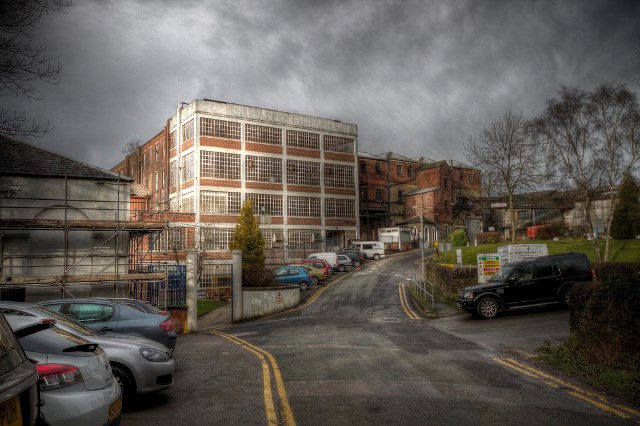
Romiley Board Mill (Click image for alternate image)
Green Lane there was a wharf serving Syddall Brothers at Chadkirk Print Works although when the railway came to Romiley this wharf fell into disuse. The history of the print works, one of the oldest in England, is related in more detail at this link.
Oakwood Mill was built as a cotton mill by Ormerod Heyworth in 1837. Operating under the name Oakwood Cotton Spinning Co it built up to 34000 mule spindles and 158 looms. In 1871, cotton spinning activities expanded with a new brick built mill added.
By 1891 it was owned by Tipping and Plant. During the First World War it became an oil refinery and then was owned for more than fifty years by the Textile Paper Tube Company, usually referred to as TPT. By 1929, the scene was set for its present use as Oakwood Mill - recycled cotton waste. This led to its present capacity with cardboard packaging following on from cotton waste. They extended the works and, at one time, employed more than 500 people there. Subsequent owners included Sonoco, an American packaging company with international operations. In August 1994, it was purchased by Preston Board and Packaging company, owned by David Hardman and Charles Ingham, as the mill was a primary supplier of unlined chipboard for them. It pulps and then processes waste paper and card into reels of cardboard, producing 55,000 tonnes per annum. Over 100 people are employed on the 22 acre site.
The coming of the railway in 1865 gave more flexibility to transport links for the area and new indus-tries were established using (or dependent on) the railway. In this respect the variety of industries that had been using the canal-side mills proved to be important in attracting new industry which took advantage of the skilled labour force. There had always been skilled artisans working on a small scale from their homes. For instance there was a clockmaker based in Bents Lane in the 1750s. However, the new companies which were establishing were much bigger and better financed.
One of the biggest was James Mills, engaged in making a variety of steel products for over 100 years.
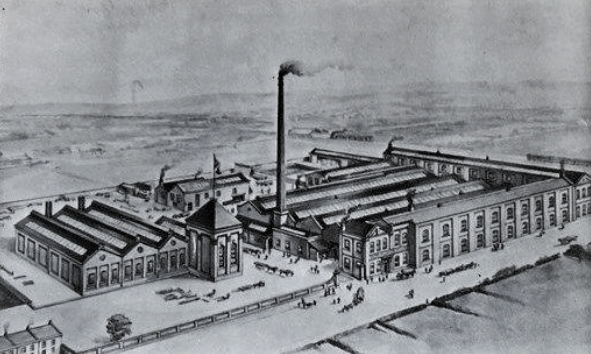
Established in 1850 in a small building employing two men, by 1871 it employed 60 men and six boys. At its height it employed 2000 people at its works on Redhouse Lane. In 1930 it was acquired by GKN and concentrated on bright steel and hot pressings.
Davies and Metcalfe Ltd. - Romiley
An engineering company employed approximately 500 people. The Head Office and works were sit-uated in Stockport Road, Romiley, where compressed air and vacuum brake equipment were manu-factured for UK and overseas railways rolling stock.
Other firms were engaged in the textile industry but in finishing trades and product manufacture. Chadkirk Printworks is believed to be the second oldest print works in the country, established in the 1760s. In 1930 it was converted into a dyeing and finishing unit for English Calico employing about 200 people and only closed in the 1980s.
Joshua Schofield and Sons Ltd. - Spring Water Dye Works, Romiley
This company was engaged in bleaching, dyeing and finishing cotton piece goods and man-made fibres, for the rubber proofing and allied trades.
Goodman and Gooder (Romiley) Ltd - Bridge Works, Romiley
The company manufactured men's, women's and children’s gloves and mittens at the Bridge Works, Romiley for over 40 years. The firm was founded in the early I920‘s when the Old Boat House Inn, on the banks of the canal at Romiley Wharf, was converted into a workshop factory. At its peak it employed 80 people but changing fashions forced its closure in the 1960s.
The variety of industry included companies specialising in consumer markets as well as industrial markets.
Wall Paper Manufacturers in Redhouse Lane moved to Bredbury from Pendleton in 1929 and for much of its existence employed almost 500 people making a wide range of wallpapers.
The Wood Finishes Division of Walpamur Co, Ltd. - Wellington Works, Mill Lane, Woodley
The finishes produced at Woodley were specially formulated for application to mass-produced woodwork of all types, particularly furniture.
J. C. Naylor and Co. Ltd. - Hyde Road, Woodley
Emery cloth and sandpaper were made by this company. All sections of industry use abrasive coated cloths and papers in some form or other, on specially designed machines, as well as for hand use.
Almost all these companies have closed down or moved as their markets changed. Bredbury still has a wide variety of small industries but these are now largely based on the industrial estate, away from the residential areas. The occupations and the skills are changing but the township still has a wide skills base and is not reliant on a handful of single industries.
Neil Mullineux, October 2022





